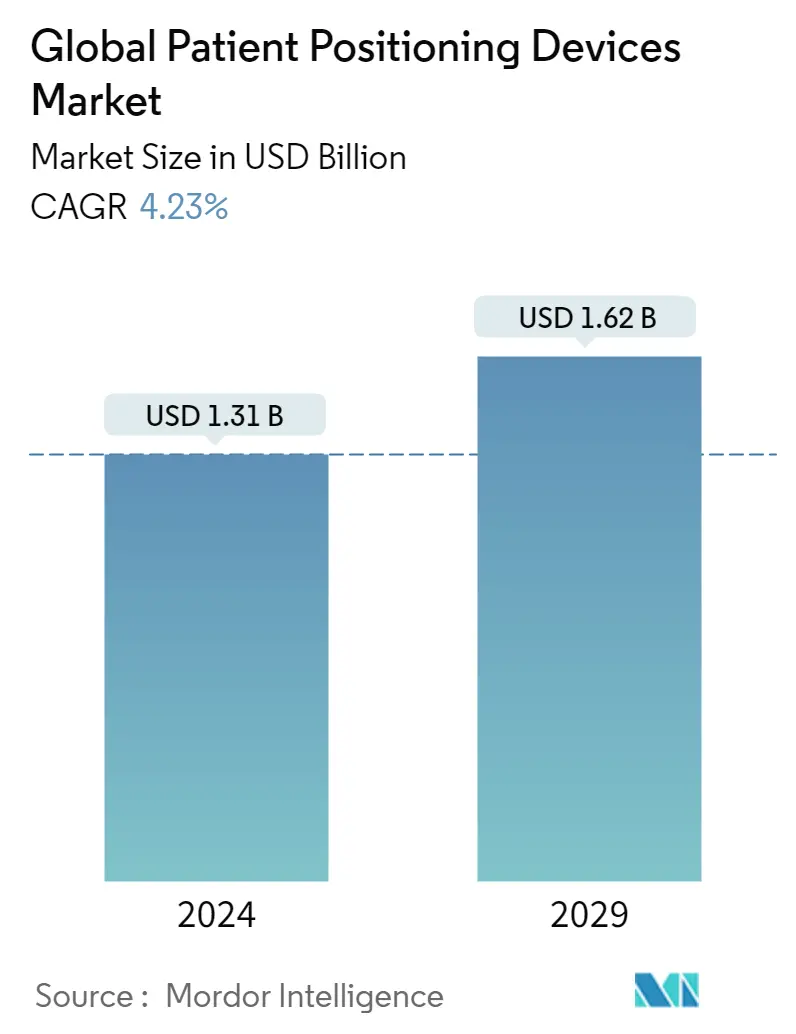Market Size of Global Patient Positioning Devices Industry

| Study Period | 2019 - 2029 |
| Market Size (2024) | USD 1.31 Billion |
| Market Size (2029) | USD 1.62 Billion |
| CAGR (2024 - 2029) | 4.23 % |
| Fastest Growing Market | Asia-Pacific |
| Largest Market | North America |
Major Players
*Disclaimer: Major Players sorted in no particular order |
Patient Positioning Devices Market Analysis
The Global Patient Positioning Devices Market size is estimated at USD 1.31 billion in 2024, and is expected to reach USD 1.62 billion by 2029, growing at a CAGR of 4.23% during the forecast period (2024-2029).
Covid-19 has significantly impacted the patient positioning devices market growth. For instance, according to the study published in IEEE Transactions on Medical Imaging in May 2020, to solve the high risk of getting infections, companies have designed and developed a contactless patient positioning system that allows for entirely remote and contactless scanning of patients. Such systems of the contactless patient position will bolster the market growth due to the rise in adopting such systems during the pandemic.
The major factors driving the market growth include the rise in the number of surgeries, the rise in hospitals and hospital investments, and the rise in the burden of the geriatric population, among others.
According to the Organisation for Economic Co-operation and Development updated in May 2022, the number of surgical procedures taking place in Norway and Denmark in 2020 were 19,201 and 54,836. Such a huge number of surgeries in the developed countries of Europe will lead to a rise in the adoption of patient positioning devices needed for surgeries, driving the market growth.
In addition, the rise in the geriatric population will lead to increased hospitalization due to various diseases in the elderly population, driving the market growth. For instance, according to the World Ageing Population 2020 highlights, in 2020, there were 727 million people aged 65 and up on the planet. Women, on average, live longer than men. Hence they make up the bulk of the elderly population, particularly at advanced ages. Such a huge burden on the elderly population will lead to increased hospitalization, thereby lead to drive the demand for patient positioning systems. Driving the market growth significantly.
Rising product launches for patient positioning are further expected to drive market growth over the forecast period. For instance, in April 2020, ExacTrac Dynamic, the next-generation patient positioning and monitoring system from Brainlab, received CE Mark (Conformité Européenne) clearance. The new system provides increased capabilities by combining never-before-seen high-speed thermal surface tracking technology with an update of ExacTrac X-ray monitoring. The launch of such systems will lead to increased adoption in radiology, driving the market growth.
However, the high cost of these systems and the availability of refurbished patient positioning systems in the market are expected to hinder the market growth.
Patient Positioning Devices Industry Segmentation
As per the scope of this report, patient positioning devices are the devices that produce ideal settings for surgeons, physicians, and patients, as proper medical posture is the most important component of surgery and other diagnostic. The patient positioning devices market is segmented by Product (Chairs, Tables (Surgical Tables, Radiolucent Imaging Tables, Examination Tables), Accessories, Other Patient Positioning Systems), Application (Surgeries, Diagnostics/Imaging, Others), End User (Hospitals, Ambulatory Surgery Centers, Diagnostic Laboratories), and Geography (North America, Europe, Asia-Pacific, Middle East, and Africa, and South America). The market report also covers the estimated market sizes and trends for 17 different countries across major regions globally. The report offers the value (in USD million) for the above segments.
| By Product | |||||
| Chairs | |||||
| |||||
| Accessories | |||||
| Other Patient Positioning Systems |
| By Application | |
| Surgeries | |
| Diagnostics/ Imaging | |
| Others |
| End User | |
| Hospitals | |
| Ambulatory Surgery Centers | |
| Diagnostic Laboratories |
| Geography | ||||||||
| ||||||||
| ||||||||
| ||||||||
| ||||||||
|
Global Patient Positioning Devices Market Size Summary
The patient positioning devices market is poised for steady growth, driven by several key factors including the increasing number of surgical procedures, the expansion of healthcare facilities, and the growing geriatric population. The COVID-19 pandemic has accelerated the adoption of innovative solutions such as contactless patient positioning systems, which have contributed to market expansion. The demand for these devices is further bolstered by the rise in hospital investments and the need for advanced medical imaging technologies. Product launches, such as Brainlab's ExacTrac Dynamic system, are expected to enhance market dynamics by offering improved capabilities in patient monitoring and positioning. However, challenges such as the high cost of these systems and the availability of refurbished options may impede market growth.
North America is anticipated to maintain a significant share of the patient positioning devices market, supported by developed healthcare infrastructure, increased healthcare spending, and the presence of major market players. The region's market growth is also fueled by the recovery of surgical procedures to pre-pandemic levels and the high demand for medical imaging solutions. The geriatric population's increasing hospitalization needs further drive market demand. The competitive landscape is characterized by collaborations and product innovations from key players like Getinge AB, Hill-Rom, Inc., and Stryker Corporation, which are actively launching new products to meet the evolving needs of the healthcare sector.
Global Patient Positioning Devices Market Size - Table of Contents
-
1. MARKET DYNAMICS
-
1.1 Market Overview
-
1.2 Market Drivers
-
1.2.1 Rising Number of Surgeries and Geriatric Population
-
1.2.2 Increase in Demand for Patient Positioning Devices in Hospitals and Clinics
-
1.2.3 Advancements in Technology
-
-
1.3 Market Restraints
-
1.3.1 HIgh Cost of Products
-
1.3.2 Availability of Refurbished Patient Positioning Systems
-
-
1.4 Porter's Five Forces Analysis
-
1.4.1 Threat of New Entrants
-
1.4.2 Bargaining Power of Buyers/Consumers
-
1.4.3 Bargaining Power of Suppliers
-
1.4.4 Threat of Substitute Products
-
1.4.5 Intensity of Competitive Rivalry
-
-
-
2. MARKET SEGMENTATION (Market Size by Value - USD million)
-
2.1 By Product
-
2.1.1 Chairs
-
2.1.2 Tables
-
2.1.2.1 Surgical Tables
-
2.1.2.2 Radiolucent Imaging Tables
-
2.1.2.3 Examination Tables
-
-
2.1.3 Accessories
-
2.1.4 Other Patient Positioning Systems
-
-
2.2 By Application
-
2.2.1 Surgeries
-
2.2.2 Diagnostics/ Imaging
-
2.2.3 Others
-
-
2.3 End User
-
2.3.1 Hospitals
-
2.3.2 Ambulatory Surgery Centers
-
2.3.3 Diagnostic Laboratories
-
-
2.4 Geography
-
2.4.1 North America
-
2.4.1.1 United States
-
2.4.1.2 Canada
-
2.4.1.3 Mexico
-
-
2.4.2 Europe
-
2.4.2.1 Germany
-
2.4.2.2 United Kingdom
-
2.4.2.3 France
-
2.4.2.4 Italy
-
2.4.2.5 Spain
-
2.4.2.6 Rest of Europe
-
-
2.4.3 Asia-Pacific
-
2.4.3.1 China
-
2.4.3.2 Japan
-
2.4.3.3 India
-
2.4.3.4 Australia
-
2.4.3.5 South Korea
-
2.4.3.6 Rest of Asia-Pacific
-
-
2.4.4 Middle-East and Africa
-
2.4.4.1 GCC
-
2.4.4.2 South Africa
-
2.4.4.3 Rest of Middle-East and Africa
-
-
2.4.5 South America
-
2.4.5.1 Brazil
-
2.4.5.2 Argentina
-
2.4.5.3 Rest of South America
-
-
-
Global Patient Positioning Devices Market Size FAQs
How big is the Global Patient Positioning Devices Market?
The Global Patient Positioning Devices Market size is expected to reach USD 1.31 billion in 2024 and grow at a CAGR of 4.23% to reach USD 1.62 billion by 2029.
What is the current Global Patient Positioning Devices Market size?
In 2024, the Global Patient Positioning Devices Market size is expected to reach USD 1.31 billion.

